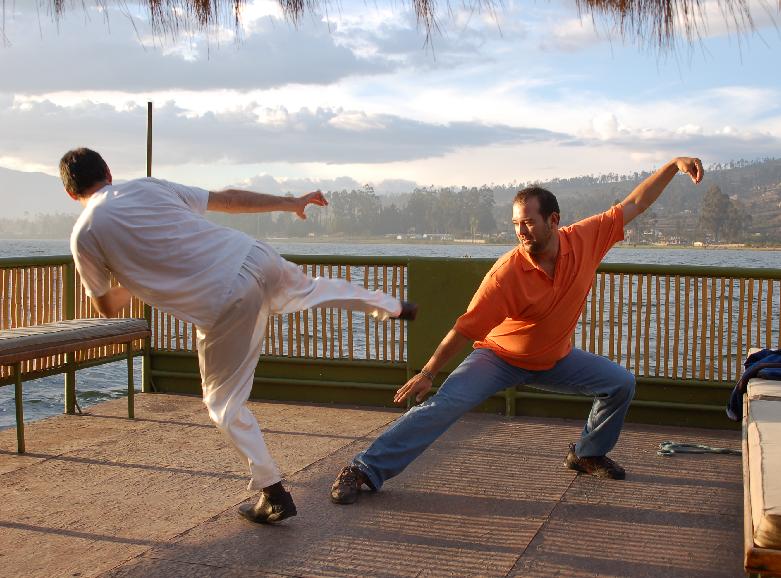AHA EXPERIENCES IN THE PRACTICE OF TAIJIQUAN

Taijiquan in a wonderful internal, martial art
Question
Would now be a good time to ask what discoveries and 'ah ha' moments you have experienced while composing the San Feng Wudang Set?
— Sifu Tim Franklin, UK
Answer
The discoveries and aha experiences occurred mostly not during the compostion of the San Feng Wudang Set, not even during the reconstruction of Wudang Taijiquan from which the San Feng Set derived, but from the time I first practiced Taijiquan.
When I composed the San Feng Wudang Set, it was mainly shortening Wudang Taijiquan to a manageable length, while maintaining the spirit, principles and benefits of Wudang Taijiquan.
When I reconstructed Wudang Taijiquan from classical sources, I already have practiced and benefited from Taijiquan for quite some time. But what struck me impressively was that the Wudang Taijiquan Set was more like a Shaolin set than what many Taijiquan practitioners conceptualized Taijiquan to be.
Even the patterns from the Wudang Taijiquan Set were like Shaolin patterns, and their names were poetic like Shaolin pattern names, and not technical like many Yang Style Taijiquan patterns and some Chen Style Taijiquan patterns.
There were many discoveries and aha experiences when I first practiced Taijiquan, which was Yang Style Taijiquan at that time. I discovered that if I performed a Taijiquan set fast, it looked like Shaolin Kungfu, and if I performed a Shaolin set slowly it looked like Taijiquan.
Even at this early age I knew that Taijiquan had to be performed fast if it had to be used for combat. This was not a problem for me, I just performed it like Shaolin Kungfu. I was able to apply all Taijiquan patterns for combat because of my training in Shaolin combat application. This was quite an aha experience as most Taijiquan practitioners did not know the martial aspect of Taijiquan.
I was quite good at Taijiquan but did not teach it despite many requests. I considered my best to be Shaolin Kungfu, and I wanted to teach my best. It was Rama who rightly commented to me that although my best was Shaolin Kungfu, many people preferred Taijiquan for some legitimate reasons, and it would be a great pity if I did not teach them, that I changed my mind.
When I taught in Australia in the 1980s, before my regular travels to teach in the West in the 1990s, Ken, a Taijiquan instructor in Bendigo, requested me to show him some Taijiquan. I taught him how to develop internal force using Lifting Water. Not only he could develop internal force in just that session when he only heard about internal force before that, I myself was amazed at the tremendous amount of internal force I developed after lifting my arms only a few times.
With hindsight I later realized that I entered in a deep chi kung state of mind, and I also led Ken into a chi kung state of mind. I concluded that if I used the same methods but different Taijiquan patterns, I could also develop internal force.
This was a discovery and aha experience. If a practitioner performs his Taijiquan set or part of it slowly and gracefully, without intellectualizing and without tensing his muscles, he could develop internal force without having to perform other internal force training methods.
It also led to my discovery and aha experience that Taijiquan itself was chi kung, and that it was unnecessary to incorporate other chi kung methods from elsewhere, like Lifting the Sky and Carrying the Moon from Eighteen Lohan Hands, into Taijiquan to develop internal force.
This discovery had far-reaching effects, and later contributed to the flow method and the otherwise ridiculous concept that making any movements, including comical or odd movements, in a chi kung state of mind, we could generate a chi flow or develop internal force! This was indeed amazing, considering that many masters had spent years chasing after internal force but to no avail.
I also discovered and had aha experiences how Taijiquan could enrich Shaolin Kungfu. If a student was rigid in his movement, by practicing his Shaolin sequences as if he was perfroming Taijiquan, he could not only overcome his rigid problem but make his movements flowing.
I discovered two important reasons why a small-sized Taijiquan exponent could defeat a bigger-sized opponent. One reason was internal force. The other reason was Taijiquan mechanics, and the core of Taijiquan mechanics was waist rotation. By rotating the waist, many Shaolin techniques that were otherwise difficult to perform, became easy.
Waist rotation led to fa-jing, or exploding force. The Taijiquan principle of "starting from the back leg, rotating the waist and ending at the hand" became very useful. By applying the principle of rotating the waist, I could help Shaolin students not only to explode spiral force in "Black Tiger Steals Heart", but make their palm strikes powerful, realizing the Shaolin principle that the palm was more powerful than the fist.
Waist rotation and exploding force were also found in Shaolin Kungfu, but were emphasized in Taijiquan. My discoveries and aha experiences in Taijiquan enriched my practice and teaching of Shaolin Kungfu.
The above is taken from Question 4 March 2016 Part 1 of the Selection of Questions and Answers.
LINKS
Courses and Classes
